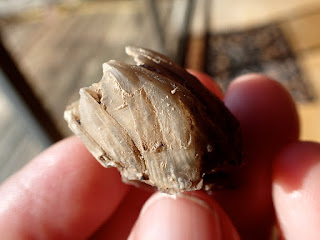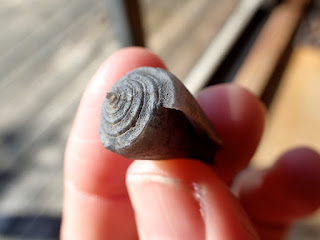...some days are stones.
I think that's somewhat redundant
but the sentiment accurately describes a recent prospecting trip that I made with Miss Vickie.
This was my take for an entire day of hard digging.
The most interesting fossil was a small piece of botryoidal coral which I don't find in the Peace River.
And on this day, I had to really appreciate the smaller things like the subtle beauty of crystallized shells, including a crystalized barnacle.
On a much more exciting note,
I know a fossil superstar!
My fossil friend and fellow club member, Josh Frank, discovered a 7,000 year old swamp burial site while diving off the Florida coast in search of megalodon teeth.
I am going to reprint the National Geographic article by Megan Gannon here on my page but you can go to the news.nationalgeographic.com site to see some footage of the underwater site as well. Very exciting fossil news!
7,000-Year-Old Native American Burial Site Found Underwater
Venice is Florida's unofficial capital of fossil hunting. Divers and beachcombers flock to this city on the Gulf Coast, mostly seeking palm-sized teeth of the Megalodon, the enormous shark species that went extinct 2 and half million years ago. In the summer of 2016, a diver searching for those relics picked up a barnacle-crusted jaw from a shallow spot off the shore of Manasota Key. The specimen sat on a paper plate in his kitchen for a couple weeks before he realized it was probably a human bone.
The diver sent a picture to Florida’s Bureau of Archaeological Research, where it landed in front of Ryan Duggins, the bureau’s underwater archaeology supervisor. A single molar was still attached to the jawbone, and the tooth’s cusps were worn smooth, likely from a diet of tough foods. “That’s something we don’t see in modern populations, so that was a quick indicator we were dealing with a prehistoric individual,” Duggins explains.
With a team of fellow underwater archaeologists, Duggins relocated the dive spot about 300 yards from the shore and 21 feet below the surface. “As soon as we were there it became clear that we were dealing with something new,” Duggins recalls. First, he spotted a broken arm bone on the seabed. Then, when he noticed a cluster of carved wooden stakes and three separate skull fragments in a depression, Duggins realized he might be dealing with a Native American bog burial site—one that had been inundated by sea level rise, but was miraculously preserved.
The discovery was announced today by the Florida Department of State.
During the last ice age, the Floridian peninsula looked more like a stubby thumb than an index finger. But beginning around 14,000 years ago, the global climate began to warm, causing glaciers to melt and sea levels to rise. Florida shrank over the next several millennia, and countless places where prehistoric people once lived, hunted, and buried their dead disappeared beneath the waves.
Marine archaeologists traditionally believed those now-submerged sites would be too fragile and ephemeral to survive the violent thrashing of the sea. “The vast majority of underwater archaeological projects have historically been focused on shipwrecks,” Duggins says. However, in the past couple of decades, some prehistoric sites, mostly scatters of stone tools, have been identified off Florida’s coast. Duggins thinks what he found near Manasota Key proves these underwater landscapes have much more archaeological potential.
In 2017, the team went back to the site to excavate a small test unit. They carefully dug through layers of peat beneath the seabed, sometimes using chopsticks and pastry brushes. They found densely packed organic remains, including more human bones, sharpened wooden stakes and textile fragments. Radiocarbon tests on the wood indicate the site dates to 7,000 years ago, during the Early Archaic period, a time when Florida’s hunter-gatherers were starting to live in permanent villages and adopt a sedentary lifestyle. So far, the researchers have counted a minimum of six individual sets of human remains, but “there’s probably going to be a lot more,” Duggins says, adding that their surveys of the site suggest the whole graveyard could spread across an acre.
“What we currently are thinking is that when an individual passed, they would have been wrapped in handwoven fibers and sunk to the bottom of the pond,” he explained. “A series of fire-hardened and sharpened stakes would be pounded into the pond bed around the body with the tops of those stakes protruding above the water line.”
Similarly, Duggins thinks the site near Venice would have been a watery graveyard, a small pond in a marsh made up of infilled sinkholes and natural springs, at a time when the site was likely 10 feet above sea level and part of Florida’s mainland.
Michael Faught, an archaeologist who pioneered prehistoric underwater archaeology in Florida, says the Manasota Key Offshore site has “impressive preservation of organic material that are rare terrestrially.”
“These items can help us reconstruct environment, subsistence, and cultural behaviors, and these data can be used to see how behaviors evolved over time, or if there are new immigrants to the area, or both,” Faught adds.
That scientific information hasn’t been gleaned from the human remains and artifacts just yet. The bones are undergoing a slow drying and desalination process at the Forensics Studies Lab run by anthropologist Heather Walsh-Haney at Florida Gulf Coast University. Once the bones enter the collection of Florida’s Bureau of Archaeological Research, the department will send out a nationwide notice to Native American tribes who may want to claim ancestry of the remains and have them repatriated under the Native American Graves Protection and Repatriation Act. Duggins is already consulting with the Seminole Tribe of Florida on respectful treatment of the remains.
“We are happy to be working, shoulder to shoulder, with the Bureau of Archaeological Research and the residents of Manasota Key to identify a preservation plan that will allow the ancestors to continue to rest peacefully and without human disturbance for the next 7,000 years,” Paul Backhouse, the tribal historic preservation officer for the Seminole Tribe of Florida, said in a statement.
Duggins has also been trying to raise awareness locally with groups like the Manasota Key Association that could help keep watch over the underwater graveyard. In Florida, removing items from an archaeological site without authorization is a misdemeanor; knowingly disturbing an unmarked grave is a felony. Thousands of people visit the nearby beaches and waters, and archaeologists don’t want a site that’s remained largely intact for millennia to be destroyed by mundane activity, like anchor dropping, or worse, looting.
“We only know about it because someone came forward,” Duggins says.





Josh is writing it up for our FCOLC newsletter!
ReplyDeleteWhat a fantastic find! Interesting article about the burial practices, and the site.
ReplyDeleteReally like the coral.